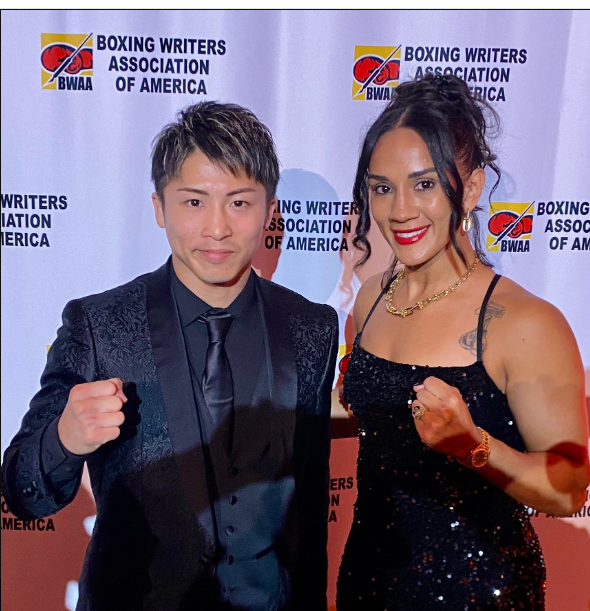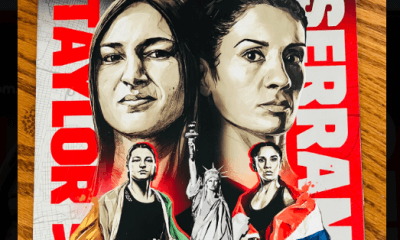Featured Articles
The Inoue and Serrano Championship Watches

Now and then, a feel-good story of particular interest surfaces in boxing. When Naoya Inoue and Amanda Serrano were presented with championship watches by the Boxing Writers Association of America on June 6 to honor their designation as the BWAA’s male and female Fighters of the Year for 2023, it continued a long history of championship adornments. And it was an important marker on the journey of a man named Bobby Ermankhah.
Boxing’s first championship belt belonged to Tom Cribb, the champion of England, who was given a lion-skin sash with silver claws after defeating Tom Molineaux of the United States in 1811. Seven decades later, Richard K. Fox (publisher of the National Police Gazette) introduced boxing belts to the United States.
Fox was engaged in a bitter feud with John L. Sullivan. When Paddy Ryan knocked out Joe Goss in 1880, the publisher presented “his” champion with a jewel-studded belt, Sullivan’s followers were so outraged that they raised $10,000 to give “their” champion a gold-plated diamond-studded prize bearing the words, “Presented to the champion of champions by the People of the United States.” Legend has it that, when John L. received his belt, he put it on and loudly proclaimed, “Fox’s is like a dog collar compared to mine.”
In 1922, Ring magazine began publication and entered the belt trade. Jack Dempsey was the first recipient of a Ring belt.
Craig Hamilton (the foremost boxing memorabilia dealer in the United States) continues the narrative, recounting, “Championship rings came into boxing with Muhammad Ali. I don’t remember seeing any before that, and relatively few fighters have had them since. As for watches, it was not uncommon for gold pocket watches to be given to fighters in the first three decades of the twentieth century. The earliest that I remember was a gold Tiffany pocket watch given to John L. Sullivan in 1907 by his fans in Boston long after Sullivan had retired from boxing. Most often, the watches were given to fighters by their manager or promoter. I know that Tommy Burns got one. And Tex Rickard gave one to Jack Dempsey around the time of the Carpentier fight. Nat Fleischer (founder of The Ring) had a collection of 93 watches that had been previously owned by fighters, But most of those were personal, not presentation, watches.”
Enter Bobby Ermankhah, the driving force behind the Inoue and Serrano championship watches.
Ermankhah was born in Tehran in 1971. His father was a high-ranking Army official during the Shah’s regime. Babak (as Bobby was known then), his older sister, and their parents lived well. Then, in 1979, the Shah was overthrown.
“After the revolution,” Ermankhah recounts, “everything changed for the country and, obviously, for my family. We went from having everything to the fear of having nothing. My father was put in prison. Eventually, he was released but he wasn’t allowed to leave Iran.”
“In 1980,” Bobby continues, “the Iraq-Iran War began. You were not drafted into the Army until you were eighteen. But after the age of fourteen, you couldn’t leave the country. My mother was against my serving in the Army and made plans for my sister and me to leave the country. We loved Iran but we didn’t like the new government. The way I was brought up; I believe in God; I believe in doing the right thing. But I don’t think you need religion to know right from wrong. For some people, it helps. But when a small group of people tell everyone else what to believe, that’s a problem for me.”
At age eleven, Ermankhah left Iran with his sister (who was three years older than he was). They spent four months in Turkey, four months in Switzerland, and eleven months in Italy. When Bobby was twelve, they arrived in the United States. After six months in New York, they got their own apartment.
“We were children, but we looked after each other the whole time,” Bobby says. “We were raised to be independent. My mother has visited us here in the United States since then. But I’ve never been back to Iran and my father isn’t allowed to leave the country, so I haven’t seen him in more than forty years.”
Ermankhah studied electrical engineering at Chelsea Vocational High School and graduated in 1990 as class valedictorian. After that, he worked as an electrician with several local unions and the Metropolitan Transportation Authority. But the electrical work dried up and he got a job as a teller for CitiBank.
“My sister had married by then,” Bobby says, continuing the saga. “Her husband had a small jewelry store in Flushing (an area of Queens, which is one of New York’s five boroughs). I’d saved some money, and I opened in Flushing a small Greek restaurant with my brother-in-law called The Greek Specialties. It did not do well. It lasted about a year-and-a-half, and I lost all the money I’d saved since I was fourteen years old. After that, I started working at my brother-in-law’s store, which was called King’s Jewelry and was also in Flushing. That was in 1994. I’d always loved watches. I bought a Rolex Datejust Twotone for $2,500. Everyone made fun of me. Who will go to Flushing to buy a Rolex? But I added some diamonds for $500 and sold it for $5,000. Then, with the $5,000, I bought two more Rolexes and sold them.”
In 1999, Ermankhah opened his own business, selling watches in a small booth in the back of an exchange at 45 West 47th Street in Manhattan. In 2005, he founded Azad.
The name “Azad” translates to “freedom” in Persian. The debut Azad collection was launched in 2008. In Ermankhah’s words, “An Azad watch is a luxury item and a statement. I start with the design and go from there. Any car can get you from one place to another, but some people like a different look. Most companies repeat what they’ve already done before and copy what everyone else is doing. Our customers want something different.”
But there were problems. In 2008, the year of Azad’s launch, the economy tanked. “It was a very difficult time for us,” Bobby acknowledges. “We didn’t sell a thing the first six months. But over time, the pace picked up.”
Azad now has eighteen different basic models that have been released in editions of twenty to five hundred pieces. Each model can be made with dozens of variables (e.g. different stones, colors, metals, bands, etc). The watches are assembled in New York. The parts come from Switzerland, Japan, and Germany, except for the cases, which are made in Hong Kong. There are ten to fifteen different suppliers of parts for each watch, which makes them harder to counterfeit. The key corporate players are vice president Cedric King and creative director Anna Zakrepine.

Meanwhile, Ermankhah is still at 45 West 47th Street in the heart of New York’s diamond district. But the Azad booth is now in the front of the store, encompassing four-and-a-half showcases and the front window. And the company recently opened a 2,000-square-foot showroom and factory on the third floor of the same building.
Insofar as the sweet science is concerned, Azad has been involved with boxing for years. It has had sponsorship deals with Madison Square Garden and Barclays Center. The first fighters to wear Azad patches on their trunks were Paulie Malignaggi, Paul Williams, Chris Arreola, and Kendall Holt. Since then, it has had relationships, among others, with Gennady Golovkin, Sergio Martinez, Jermain Taylor, Andre Berto, Danny Garcia, Deontay Wilder, and John Duddy.
“Boxers work hard to get what they get,” Ermankhah says. “They deserve recognition, but only a few champions are recognized on the street. You can’t walk around wearing your championship belt to show that you’re a champion. But you can always wear a watch.”
That brings us to the championship watches presented to Naoya Inoue and Amanda Serrano at the June 6 BWAA awards dinner. The design and red-and-white color motif of Inoue’s watch are evocative of the Japanese flag. It’s inner movements are visible from both the front and back. The stainless steel case is encrusted with more than two hundred diamonds. On its back, the watch reads, “Naoya Inoue, 2023 BWAA Fighter of the Year.”
Serrano’s watch is from Azad’s prestige Zada collection and, like Inoue’s, has a stainless steel case encrusted with diamonds.
“I’d love to make a one-of-a-kind watch for every BWAA Fighter of the Year in the future,” Ermankhah says. “It would be an honor.”
Is this the start of a new tradition?
Thomas Hauser’s email address is thomashauserwriter@gmail.com. His most recent book – MY MOTHER and me – is a personal memoir available at Amazon.com. https://www.amazon.com/My-Mother-Me-Thomas-Hauser/dp/1955836191/ref=sr_1_1?crid=5C0TEN4M9ZAH&keywords=thomas+hauser&qid=1707662513&sprefix=thomas+hauser%2Caps%2C80&sr=8-1
In 2004, the Boxing Writers Association of America honored Hauser with the Nat Fleischer Award for career excellence in boxing journalism. In 2019, Hauser was selected for boxing’s highest honor – induction into the International Boxing Hall of Fame.
To comment on this story in the Fight Forum CLICK HERE
-

 Featured Articles3 weeks ago
Featured Articles3 weeks agoVito Mielnicki Jr Whitewashes Kamil Gardzielik Before the Home Folks in Newark
-

 Featured Articles3 days ago
Featured Articles3 days agoResults and Recaps from New York Where Taylor Edged Serrano Once Again
-

 Featured Articles1 week ago
Featured Articles1 week agoFrom a Sympathetic Figure to a Pariah: The Travails of Julio Cesar Chavez Jr
-

 Featured Articles4 weeks ago
Featured Articles4 weeks agoCatching Up with Clay Moyle Who Talks About His Massive Collection of Boxing Books
-

 Featured Articles2 days ago
Featured Articles2 days agoResults and Recaps from NYC where Hamzah Sheeraz was Spectacular
-

 Featured Articles1 week ago
Featured Articles1 week agoCatterall vs Eubank Ends Prematurely; Catterall Wins a Technical Decision
-

 Featured Articles3 weeks ago
Featured Articles3 weeks agoMore Medals for Hawaii’s Patricio Family at the USA Boxing Summer Festival
-

 Featured Articles3 days ago
Featured Articles3 days agoPhiladelphia Welterweight Gil Turner, a Phenom, Now Rests in an Unmarked Grave


















